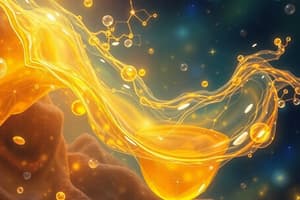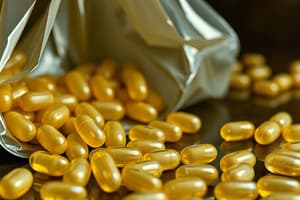Podcast
Questions and Answers
What is the primary reason why gelatin is not a nutritionally complete protein?
What is the primary reason why gelatin is not a nutritionally complete protein?
- It lacks tryptophan and has low levels of isoleucine, threonine, and methionine (correct)
- It has high levels of hydroxyproline and glycine
- It can only be sourced from animal products
- It is insoluble in organic solvents like alcohol
What is the function of glycine in gelatin's structure?
What is the function of glycine in gelatin's structure?
- It acts as a solvent for the gelatin
- It provides a loose conformation to the chains
- It is responsible for the gelation process
- It is in charge of the chains' tightly packed structure (correct)
What is the significance of proline in gelatin's gelation properties?
What is the significance of proline in gelatin's gelation properties?
- It increases the viscosity of the gel
- It acts as a solvent for the gelatin
- It restricts the conformation of the chains, which is crucial for gelation (correct)
- It promotes the gelation process
What is the reason behind gelatin's thixotropic behavior?
What is the reason behind gelatin's thixotropic behavior?
What is the approximate percentage of protein in dry gelatin?
What is the approximate percentage of protein in dry gelatin?
What is the significance of hydroxyproline in gelatin's composition?
What is the significance of hydroxyproline in gelatin's composition?
What is the primary solvent for dissolving gelatin?
What is the primary solvent for dissolving gelatin?
What is the reason behind gelatin's ability to absorb water and form a gel?
What is the reason behind gelatin's ability to absorb water and form a gel?
What is the melting point of gelatin dependent on?
What is the melting point of gelatin dependent on?
What is the primary composition of hydrolyzed collagen?
What is the primary composition of hydrolyzed collagen?
Flashcards are hidden until you start studying
Study Notes
Gelatin: Properties and Applications
- Gelatin is a protein generated from collagen, found in animal bones, cartilage, and skin.
- It is crucial for healthy joints and is commonly used in desserts, broths, soups, sauces, candies, and medications.
Properties
- Gelatin is a collection of peptides and proteins produced by partial hydrolysis of collagen.
- It has gelling properties, forming a gel when dissolved in water and cooled.
- Gelatin is clear, colorless, and non-reactive, making it versatile for use in foods and pharmaceuticals.
- It can come in sheets, flakes, or powder form and is soluble in polar solvents like hot water, glycerol, and acetic acid.
- Gelatin absorbs 5–10 times its weight in water to form a gel.
- The gel formed by gelatin can be melted by reheating and has an increasing viscosity under stress (thixotropic).
- Gelatins have diverse melting points and gelation temperatures depending on the source.
Composition
- Dry gelatin contains 98–99% protein, but lacks tryptophan and has low levels of isoleucine, threonine, and methionine, making it not a nutritionally complete protein.
- Collagen and hydrolyzed collagen have the same amount of amino acids.
- Proline (10–18%), hydroxyproline (7–15%), and glycine (26–34%) make up the majority of the 19 amino acids found in hydrolyzed collagen, accounting for approximately 50% of the total amino acid composition.
- Glycine is responsible for the tightly packed structure of gelatin chains.
- The presence of proline restricts the conformation, which is crucial for gelatin's ability to gel.
Applications
- Unrefined gelatin is present in some animal glues, including hide glue.
- Silver halide crystals are held in an emulsion in almost all photographic films and photographic sheets by gelatin.
- Gelatin is used as a separating, coating, or carrier agent for other chemicals, making β-carotene soluble in water and giving soft drinks their characteristic yellow hue.
- Ballistic gelatin is used in gunshot performance testing and measurement.
Industry Applications
- Food Industry: used in Jell-O, gummy candies, providing texture and stability.
- Pharmaceuticals: used in gel capsules, encapsulating medication for easy ingestion.
- Cosmetics: used in face masks, shampoos, adding protein and texture to products.
Classifications and Economic Importance
- Type A Gelatin: derived from acid-cured tissues.
- Type B Gelatin: derived from alkaline-cured tissues.
- Gelatin is integral to food processing and pharmaceutical manufacturing, with increasing use in beauty and wellness products.
Religious Considerations
- Certain animals' gelatin may be beyond limits due to cultural taboos or religious regulations.
- Jewish kosher and Islamic halal standards typically demand gelatin from sources other than pigs, such as fish or cattle slaughtered in accordance with religious laws.
Dental Uses
- Gelatin is used in dentistry as an ingredient in dentifrices due to its antacid properties.
- It is used to reduce the acidity of oral fluids and to obturate dentine, which is sensitive.
- Gelatin is used as a polishing powder for metal and plastic work in the dental laboratory.
Studying That Suits You
Use AI to generate personalized quizzes and flashcards to suit your learning preferences.




